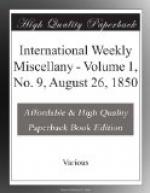they acquired he retained for a longer period than
any one of his contemporaries; from his first appearance
in the fashionable world in the year 1746, to the
year he left it forever, in 1810, at the age of eighty-five,
he was always an object of comparative notoriety.
There was no interregnum in the public course of his
existence. His first distinction he achieved on
the turf; his knowledge of which, both in theory and
practice, equaled that of the most accomplished adepts
of Newmarket. In all his principal matches he
rode himself, and in that branch of equitation rivaled
the most professional jockeys. Properly accoutered
in his velvet cap, red silken jacket, buckskin breeches,
and long spurs, his Lordship bore away the prize on
many a well-contested field. His famous match
with the Duke of Hamilton was long remembered in sporting
annals. Both noblemen rode their own horses,
and each was supported by numerous partisans.
The contest took place on the race-ground at Newmarket,
and attracted all the fashionables of the period.
Lord March, thin, agile, and admirably qualified for
exertion, was the victor. Still more celebrated
was his Lordship’s wager with the famous Count
O’Taafe. During a conversation at a convivial
meeting on the subject of ‘running against time,’
it was suggested by Lord March, that it was possible
for a carriage to be drawn with a degree of celerity
previously unexampled, and believed to be impossible.
Being desired to name his maximum, he undertook, provided
choice of ground were given him and a certain period
for training, to draw a carriage with four wheels
not less than nineteen miles within the space of sixty
minutes. The accomplishment of such rapidity
staggered the belief of his hearers; and a heavy wager
was the consequence. Success mainly depending
on the lightness of the carriage, Wright of Long Acre,
the most ingenious coach-builder of the day, devoted
the whole resources of his skill to its construction,
and produced a vehicle formed partly of wood and partly
of whale-bone, with silk harness, that came up to
the wishes of his employer. Four blood horses
of approved speed were then selected, and the course
at Newmarket chosen as the ground of contest.
On the day appointed, 29th of August, 1750, noble and
ignoble gamesters journeyed from far and near to witness
the wonderful experiment; excitement reached the highest
point, and bets to an enormous amount were made.
At length the jockeys mounted; the carriage was put
in motion, and rushing on with a velocity marvelous
in those times of coach traveling, but easily conceived
by us railway travelers of the nineteenth century,
gained within the stipulated hour the goal of victory.”
* * * * *
THE DECAY OF GREAT FAMILIES.
Not the least valuable parts of Burke’s just published “Anecdotes of the Aristocracy,” are a species of essay on the fortunes of families. The following is from a chapter on their decadence:




